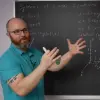

NARROW DISPLAY WARNING
You are most likely using a tablet or mobile device in portrait orientation. This website is best viewed using a typical computer screen with the browser window maximized.
Viewing this website in portrait orientation can cause problems with equations being longer than the screen width (you can scroll to the right), images being poorly sized, and the font size of maths text being much smaller than regular text. If your only option is a tablet or mobile device, your viewing experience will be better if you view this website in landscape orientation. You might need to refresh the page to fix any problems after rotating.
The ideal models of a resistor, capacitor, and inductor (RLC) connected in series with a battery result in an ODE with the same form as a spring-mass-damper system. All the behaviours and analysis can be applied directly to analysing an RLC circuit in series.
For the following RLC circuit,
The ODE governing its behaviour is,
\begin{equation} LQ'' + RQ' + \frac{1}{C}Q = E(t) \end{equation}where R, L, C, and E(t) are the resistance, inductance, capacitance, and impressed voltage as a function of time.
Most math textbooks do not explain the physics of the model in depth and instead just state equations to use for each component. There are many physics based explanations online if that is of interest.
Make the ODE for the RLC circuit given the following relationships:
Voltage drop across a capacitor $= \dfrac{Q(t)}{C}$ where $Q(t)$ is the charge stored on the capacitor.
Voltage drop across a resistor $= RI(t)$ where $I(t)$ is the current flowing through the resistor.
Voltage drop across an inductor $= L\dfrac{\text{d}I}{\text{d}t} = LI'(t)$.
The rate of change of charge, $Q'(t)$, on the capacitor is the current $I(t)$.
Kirchhoff's Voltage Law states the sum of voltages around a loop is zero.